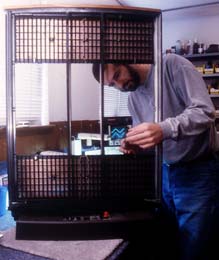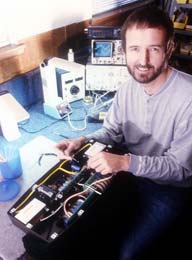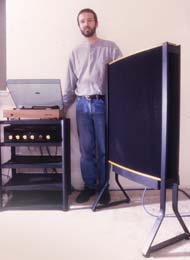
QUAD MOD:
Tweaking, tickling and otherwise upgrading a
classic speaker
by Joel Shumer
Remember the girl who had a little curl right in the middle of her forehead?
When she was good, she was very, very good, but when she was bad, she
was horrid. The Quad ESL 63 electrostatic speakers are a bit that way.
In 1987, I bought a new pair of Pro 63s, all but identical to the U.S.A.
Monitors introduced a few months later. For the past decade, I have relied
on these speakers both as a reference and for the sheer pleasure of enjoying
music. String tone and the human voice, particularly women's voices, have
natural balance and timbre that is remarkably free of colorations. The
speakers can reproduce sharp, clean transients and the subtle microdynamics
which can give the breath of life to recorded music. Listening late at
night, with low volume and subdued lighting to an old Joan Baez LP or
the Kodaly String Quartet playing Haydn comes as close to transporting
me to the "you are there" experience as I am able to get. Even
the current Wilson WATT/Puppy v.1, which I own and have used in side-by-side
comparisons, can not match the naturalness and sense of presence provided
by my premodification Quads.
Like the girl with the curl, given the right recordings, the 63s can be
very, very good; and although they are never really horrid, if I play
recordings which confront their limitations, they can behave quite badly
for speakers costing $6,000 per pair. Today one can buy speakers priced
at less than a third of the cost of new Quads that can play louder, have
superior macrodynamics, and push a lot more air at 40 Hz which is needed
for that "bass in the gut" wallop
Recently I heard Leonard Slatkin conduct the New York Philharmonic in Copland's Third Symphony. In the last movement, there is a series of loud percussive mini-explosions where the timpanist hits two kettle drums in sync with another percussionist whacking a large bass drum. The auditory effect is electrifying! At home, listening to a Telarc (CD 80201) recording of the work conducted by Yoel Levi, much of that visceral experience can be reproduced with the WATT/Puppies. When I switch to the 63s, it just isn't there. The sound is clean and natural, but the Quads can't push enough air in that 30- to 50-Hz region to raise goose bumps. Accurate? Yes, but scaled down, and as a result, the music loses much of its emotional impact.
To Modify or Not To Modify: That Is The Question?
 The
point of the preceding paragraph is not to belittle the Quad 63s. With
what they do best, in an optimal set up, they are without peer. But if
someone wants speakers that can play loud, have wide dynamics, deep bass,
and mid bass with impact, then the 63s are a very poor choice. I know
of no modifications other than adding a crossover and subwoofer that address
any of these shortcomings. But the 63s can be improved. And what they
do best can be made to sound even better.
The
point of the preceding paragraph is not to belittle the Quad 63s. With
what they do best, in an optimal set up, they are without peer. But if
someone wants speakers that can play loud, have wide dynamics, deep bass,
and mid bass with impact, then the 63s are a very poor choice. I know
of no modifications other than adding a crossover and subwoofer that address
any of these shortcomings. But the 63s can be improved. And what they
do best can be made to sound even better.
For a $6,000.00 speaker, the manufacturer has taken a number of cost-saving
shortcuts. Most of the Quad 63 modifications involve replacing poor-quality
parts and wire with high-quality audiophile materials and reducing unwanted
vibrations when the frames are rebuilt. Acoustical Manufacturing, the
British maker of the Quads, has made a number of improvements as well
since the 63s were introduced in 1981. If older speakers are to be modified,
newer clamp boards, grilles, and speaker terminals can also be incorporated.
But back to the question, "Should one modify Quad 63s?" The
answer is "no" if an owner of 63s hopes to transform them into
loud, dynamic, big-bass speakers. But if one loves the 63s’ see-through
transparency and lack of coloration, and can accept the speakers' limitations,
then the answer can be a "Yes.” The sonic virtues that make
Quads unique can be further enhanced. The judicious modification and replacement
of parts by a knowledgeable person, both technically skilled and with
an appreciative ear for the aural nuances brought on by each little change
in the speaker, is absolutely necessary. And I believe I’ve found
just such a man.
Enter Nick Gowan
 Nick
Gowan owns True Sound, a small company in Campbell, California where a
major part of his work is repairing, rebuilding, and improving vintage
audio components. Judging by his enthusiasm, which was readily apparent
in our many phone conversations, Nick is a man who loves his work.
Nick
Gowan owns True Sound, a small company in Campbell, California where a
major part of his work is repairing, rebuilding, and improving vintage
audio components. Judging by his enthusiasm, which was readily apparent
in our many phone conversations, Nick is a man who loves his work.
We talked about my 63s and how they could be made to sound better. What
Nick really wanted was to get his hands on my speakers, give a listen
and after partial disassembly come up with a list of suggested modifications.
I found him convincing and decided to take the next step. Nick was able
to locate a pair of shipping cartons and have them sent to me. Despite
the speakers’ light weight and lack of foam inserts for the boxes,
Nick assured me that the speakers would have adequate protection, and
so I consigned my 63s to UPS for their transcontinental journey. A few
days later the phone rang and Nick's cheery voice announced that the speakers
had arrived without damage and sounded quite good. He would phone back
in a day or two with recommendations. After he called again, I felt confident
that he knew what he was doing, so I gave him a green light to go ahead
with his modification plan.
Modifying The 63s
First Nick completely disassembled each speaker by removing the four
electrostatic panels and dismantling the metal frames. The frames and
separated bases were then reassembled but with added damping material
in the joints to reduce resonances. Then the panels were securely refitted.
In the next stage, the original low-quality, single-conductor wire was
replaced with 60 feet of multi-stranded 99.99997 percent (six nines with
a plus) pure copper wire. He then wired the input posts to the circuit
board and to the chassis with Audio Note AN-D. Nick fitted wire links,
coupling the ends of the traces on the tweeter panels to each other, so
there would be no electrical imbalances between them. Nick explains, "Quad
originally made provision for this coupling but never implemented this
procedure in production, probably because it was too labor-intensive and
time-consuming.”
The only original speaker inputs on my 63s were banana plugs and these
had worked themselves loose. Nick replaced them with rugged five-way binding
posts. With this modification, the signal path had now been completely
rewired, all connections having been cleaned and resoldered with an audiophile-quality,
silver-based solder.
Nick then added an additional 8-mF, audio-grade bypass capacitor to the
input circuit, thus improving the accuracy of the high-frequency performance,
as well as smoothing out the input impedance curve of the speaker. Improved
clamping boards from Quad were fitted to help prevent damage from overdriving
the speakers with too high a signal.
My 63s have the newer, more open grilles, and so did not have to be replaced.
Nick just grounded them and refitted them to the frames. However, he wrapped
their edges with a black cloth tape to further reduce vibration. The tape
also makes a neat visual frame for the grilles which can now be seen through
a new sheer grill cloth that replaces the heavier material used by Quad.
Completely reassembled, Nick measured the response and output sensitivity
on a spectrum analyzer. For his final listening test, he uses an Audio
Note Soro Signature single-ended, integrated tube amplifier. Nick reports
that even though the new wiring had not broken in, he was "extremely
pleased with the way they sounded.” A week later, the speakers were
back in my New Jersey home, and despite the reuse of these same flimsy
cartons, they were unharmed by their three thousand mile return trip.
Thanks, UPS!
Listening
My newly modified Quad 63s did sound good. In fact, they sounded great!
It was a joy to have them back in the system. The WATT/Puppies can run
metaphorical rings around the 63s in some areas, but where the Quads had
always been superior, the modified Quad 63s widened that gap.
Listening critically, one of my early observations was that a slight tizzyness
in the 1- to 3-kHz region had all but vanished. I've heard this slightly
brightish, ringing glare that places a grainy halo on some high notes
and overtones on some but not all other Quad 63s. Perhaps Nick's damping
materials had provided the cure.
Recordings also seemed cleaner and clearer. It's as though there had been
a bit of haze around each voice and instrument that was now wiped clean.
There is more spatial information as well. I am more aware of the location
of each performing artist, as well as of the space around and behind the
performer.
High- and low-frequency extremes have also been extended, and the highs
are more open. There is a greater sense of presence with absolutely no
increase of the whitish glare that often accompanies such extension. Compared
with most dome tweeters, the modified 63s still sound slightly rounded
on top, but then so do most concert hall performances. When sitting on-axis,
the 63s now reproduce upper octaves with an accuracy that makes the naturalness
of the reproduced sound much more dependent on recordings, components,
and other accessories in the system than the speakers themselves.
Bass also seems more extended, supportive, and with a greater sense of
solidity. It's hard to imagine why this should be so, but I had a similar
sense of improved bass when I switched the power supply for my Linn LP
12 turntable from the Valhalla board to Linn's much larger and costlier
Lingo power supply.
Two other areas that have been slightly improved are the already excellent
microdynamics and transients. As a result, piano recordings, if not played
too loudly, do a better job of separating each note from the note or notes
just heard, and well as from whatever else may be going on in the recording.
It's as though each note were emerging from a black background with greater
clarity and surrounded with less clutter.
Conclusions and Recommendations
 The
Quad ESL 63s, as modified by Nick Gowan, have been substantially improved.
They are more reliable, safer, more pleasing to the eye, and have gained
solidity in their reconstruction. Most importantly, they sound better.
The purity, openness, and immediacy that have been Quad hallmarks have
been further enhanced. Frequency extremes are extended. Microdynamics,
transients, and spatial information are all improved. Nick Gowan's modified
63s do what Quads do best, only more so.
The
Quad ESL 63s, as modified by Nick Gowan, have been substantially improved.
They are more reliable, safer, more pleasing to the eye, and have gained
solidity in their reconstruction. Most importantly, they sound better.
The purity, openness, and immediacy that have been Quad hallmarks have
been further enhanced. Frequency extremes are extended. Microdynamics,
transients, and spatial information are all improved. Nick Gowan's modified
63s do what Quads do best, only more so.
At a cost of $2,500.00, this is not an inexpensive series of modifications.
The work is time-consuming, and Nick tells me that about two-thirds of
the cost is his labor. For the person who cherishes the unique sound of
the 63s and can live with their limitations, these modifications make
a lot of sense. I've heard quite a few speakers and I know of no speaker
with a more natural mid-range and upper octaves. Based on my experience,
such speakers aren't being made, and improving the Quad 63s becomes a
more logical choice than buying new speakers.
For those who wish to pursue this further, I'd suggest giving Nick a call.
He can give you a pretty good idea of what can be done with your Quads.
Another possibility is to look for a good used pair of 63s which often
sell for under $2,000. Again, call Nick. Not only is he an authorized
distributor of new Quad 63s but he can be quite helpful in describing
what to look for in buying an older pair. The combined cost of buying
and modifying secondhand speakers would be less than the cost of buying
new ones and can result in speakers that are sonically superior.
In sum, the person who feels frustrated by the Quad 63s lack of dynamic
punch and bass impact should forget the mods. Even with Nick Gowan's work,
this person will probably remain frustrated. For those who can live with
what the 63s don't do well, and love the Quad 63s for those areas where
they excel, the modifications make a great deal of sense. Nick Gowan has
shown that he is able to take one of the best sounding speakers in the
world and with his expertise and skill make it into one that is even better.
Notes
Quad ESL 63 Modification, approximately $2,500.00
from Nick Gowan, True Sound,136 Kennedy Ave., Campbell, CA 95008; phone
408/370-7578, FAX 408/370-7581, e-mail gowan@tsound.com.
Associated Equipment
Analog source: Linn LP 12/Lingo turntable with Ekos arm; Koetsu Rosewood
signature cartridge;
Digital Source: Linn Karik/Numerik CD player;
Electronics: Audio Research SP-11 phono stage, Audio Research
LS 15 preamplifier, Pass Laboratories Aleph 2 monoblocks and Audio Research
VT 100 amplifiers;
Speakers: Wilson Audio WATT/Puppy V.1;
Interconnects: Daniels Audio, Audio Research;
Speaker Cable: Tara RSC Master generation 2, and
Accessories: Tice Power Block, Bob Young Line Filters, ASC Tube Traps,
G. and G. Discoveries Pon-Tunes, Target equipment stands.
[used with the permission of The Audiophile Voice]
© True Sound, 2009